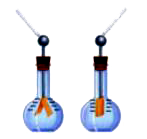Name the negatively charged and positively charged components of a nucleosome.
Step by step video & image solution for Name the negatively charged and positively charged components of a nucleosome. by Biology experts to help you in doubts & scoring excellent marks in Class 12 exams.
Updated on:21/07/2023Topper's Solved these Questions
Similar Questions
Is haemoglobin negatively or positively charged sol?
View SolutionName:
a positively charged non-metallic ion.
View SolutionIf an object made of substance A is rubbed with an object made of substance B, then A becomes positively charged and B becomes negatively charged. If however, an object made of substance C, then A becomes negatively charged, What will happen if an object made of substance B is rubbed against an object made of substance C?
(a) B becomes positively charged and C becomes positively
(b) B becomes positively charged and C becomes negatively charged.
(c ) B becones negatively charged and C becomes positively charged.
(d) B becomes negatively charged and C becomes negatively charged.
View SolutionAn electrolytic cell consists of
(i) positively charged cathode
(ii) negatively charged anode
(iii) positively charged anode
(iv) negatively charged cathode
View SolutionFor packing of a negatively charged DNA, a positively charged histone molecules rich in basic amino acids are required. This histones are formed during :
View SolutionName the polyatomic ion that carries a positive charge.
View SolutionIn case of electronic current the charge flows from negatively charged body to the Positively charged body. The body which is at higher potential is :
View SolutionMetal sol is negatively charged. True/False
View SolutionObserve the picture given below. Which one would be a negatively charged object and which one would be a positively charged object?

View SolutionAn isolated conducting spherical shell carries a negative charge. What will happe if a positively charged metal object is placed in contact with the shell interior? Assume that the positive charge is (a) less than (b) equal to (c ) greater than the negative charge in magnitude.
View Solution
